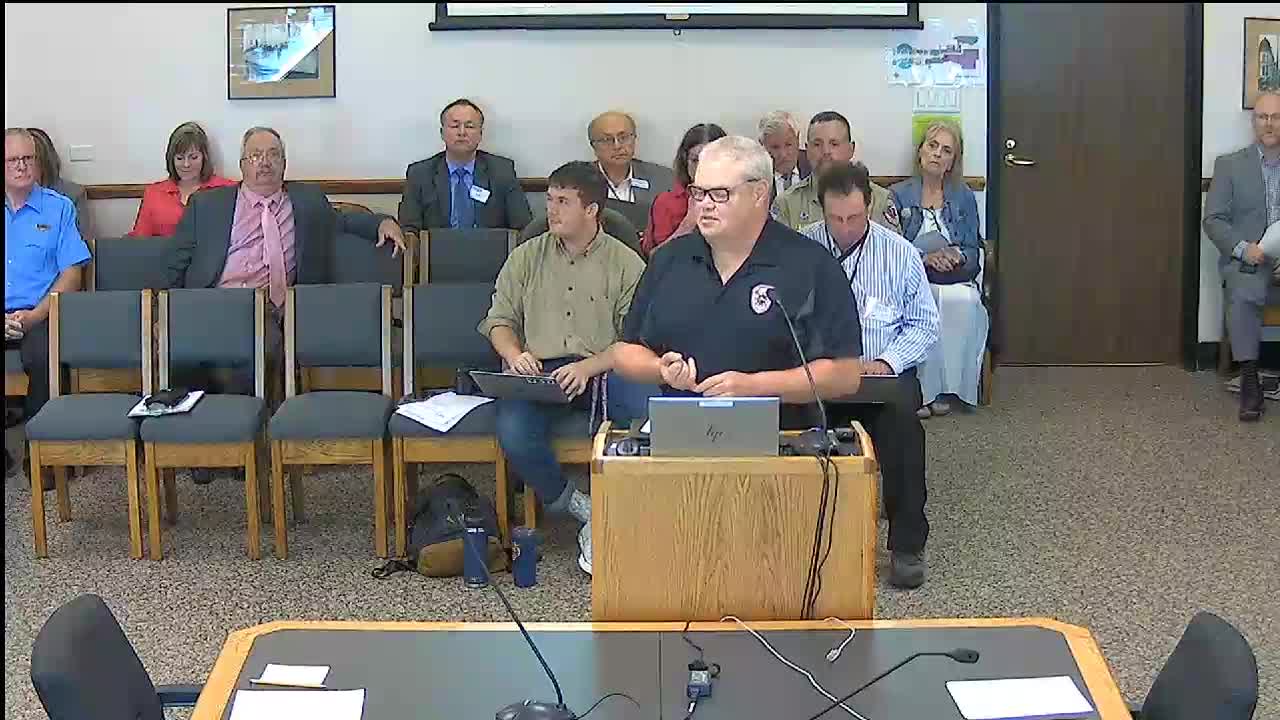Fire Chief Discusses Volunteer Challenges and Emergency Response Funding in North Dakota
August 20, 2025 | Legislative, North Dakota
This article was created by AI summarizing key points discussed. AI makes mistakes, so for full details and context, please refer to the video of the full meeting. Please report any errors so we can fix them. Report an error »

In a meeting held on August 20, 2025, the Emergency Response Services Committee of the North Dakota Legislature gathered to address pressing issues facing fire departments across the state. The atmosphere was charged with urgency as committee members discussed the challenges of maintaining effective emergency response services amid rising costs and evolving hazards.
One of the key topics was the impact of Insurance Services Office (ISO) ratings on local fire departments. A representative highlighted the financial burden of upgrading equipment to improve ISO ratings, noting that smaller departments often struggle to justify the expense of new ladder trucks or hiring additional firefighters. The discussion revealed a complex relationship between ISO ratings and insurance premiums, with lower ratings potentially leading to reduced tax revenues for departments, complicating their financial stability.
The meeting also delved into the physical and mental health challenges faced by firefighters. The demanding nature of the job exposes them to hazardous materials and high-stress situations, which can lead to serious health issues, including heart disease and mental health struggles. A poignant personal account from a veteran EMT illustrated the emotional toll of responding to traumatic incidents, underscoring the need for better support systems for emergency responders.
Healthcare coverage for firefighters was another critical issue. The committee discussed the limitations of Workers' Compensation Insurance (WSI) and the challenges faced by firefighters who do not qualify for coverage after on-the-job injuries. This gap in coverage can deter potential recruits and strain existing resources, as departments are forced to rely on supplemental insurance plans that can drain operational budgets.
As the conversation shifted to the evolving landscape of emergency response, members acknowledged the increasing frequency of natural disasters, such as tornadoes and wildfires. The growing use of alternative energy sources, like lithium batteries, presents new challenges for firefighting techniques, necessitating ongoing training and adaptation.
Funding for volunteer fire departments emerged as a significant concern. Many departments operate under strict budget constraints, often limited by mill levies that cap their funding potential. The committee discussed the need for a more flexible funding structure to ensure that rural departments can maintain adequate equipment and training.
The meeting concluded with a call for greater public awareness of the vital role that volunteer firefighters play in their communities. Many residents remain unaware that their emergency services are provided by volunteers, which can hinder recruitment efforts. The committee emphasized the importance of fostering a supportive environment for volunteers, including regional training programs and public outreach initiatives.
As the committee wrapped up, it became clear that the challenges facing North Dakota's emergency response services are multifaceted and require collaborative solutions. The discussions highlighted the need for ongoing support, funding, and public engagement to ensure that these essential services can continue to protect and serve communities across the state.
One of the key topics was the impact of Insurance Services Office (ISO) ratings on local fire departments. A representative highlighted the financial burden of upgrading equipment to improve ISO ratings, noting that smaller departments often struggle to justify the expense of new ladder trucks or hiring additional firefighters. The discussion revealed a complex relationship between ISO ratings and insurance premiums, with lower ratings potentially leading to reduced tax revenues for departments, complicating their financial stability.
The meeting also delved into the physical and mental health challenges faced by firefighters. The demanding nature of the job exposes them to hazardous materials and high-stress situations, which can lead to serious health issues, including heart disease and mental health struggles. A poignant personal account from a veteran EMT illustrated the emotional toll of responding to traumatic incidents, underscoring the need for better support systems for emergency responders.
Healthcare coverage for firefighters was another critical issue. The committee discussed the limitations of Workers' Compensation Insurance (WSI) and the challenges faced by firefighters who do not qualify for coverage after on-the-job injuries. This gap in coverage can deter potential recruits and strain existing resources, as departments are forced to rely on supplemental insurance plans that can drain operational budgets.
As the conversation shifted to the evolving landscape of emergency response, members acknowledged the increasing frequency of natural disasters, such as tornadoes and wildfires. The growing use of alternative energy sources, like lithium batteries, presents new challenges for firefighting techniques, necessitating ongoing training and adaptation.
Funding for volunteer fire departments emerged as a significant concern. Many departments operate under strict budget constraints, often limited by mill levies that cap their funding potential. The committee discussed the need for a more flexible funding structure to ensure that rural departments can maintain adequate equipment and training.
The meeting concluded with a call for greater public awareness of the vital role that volunteer firefighters play in their communities. Many residents remain unaware that their emergency services are provided by volunteers, which can hinder recruitment efforts. The committee emphasized the importance of fostering a supportive environment for volunteers, including regional training programs and public outreach initiatives.
As the committee wrapped up, it became clear that the challenges facing North Dakota's emergency response services are multifaceted and require collaborative solutions. The discussions highlighted the need for ongoing support, funding, and public engagement to ensure that these essential services can continue to protect and serve communities across the state.
View full meeting
This article is based on a recent meeting—watch the full video and explore the complete transcript for deeper insights into the discussion.
View full meeting
